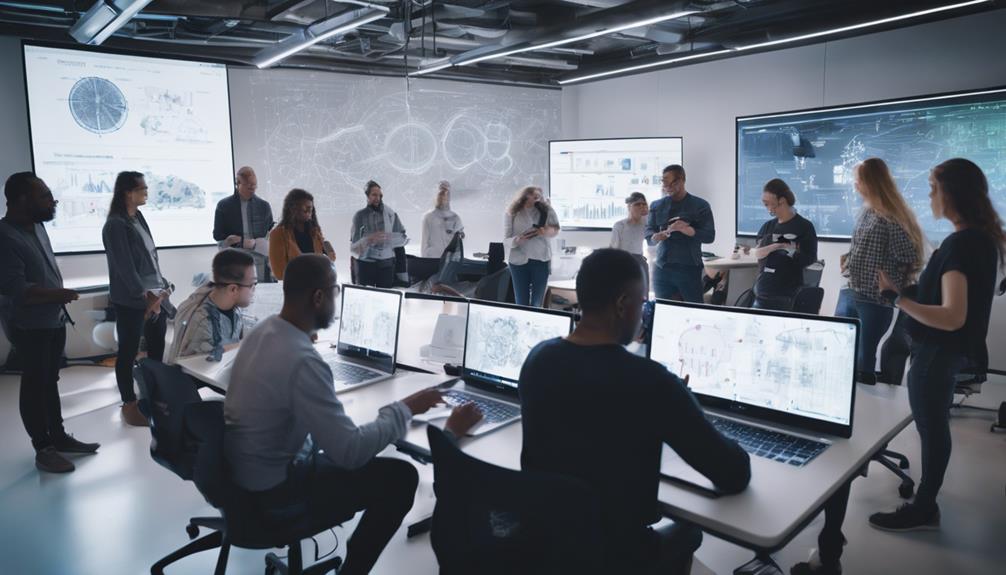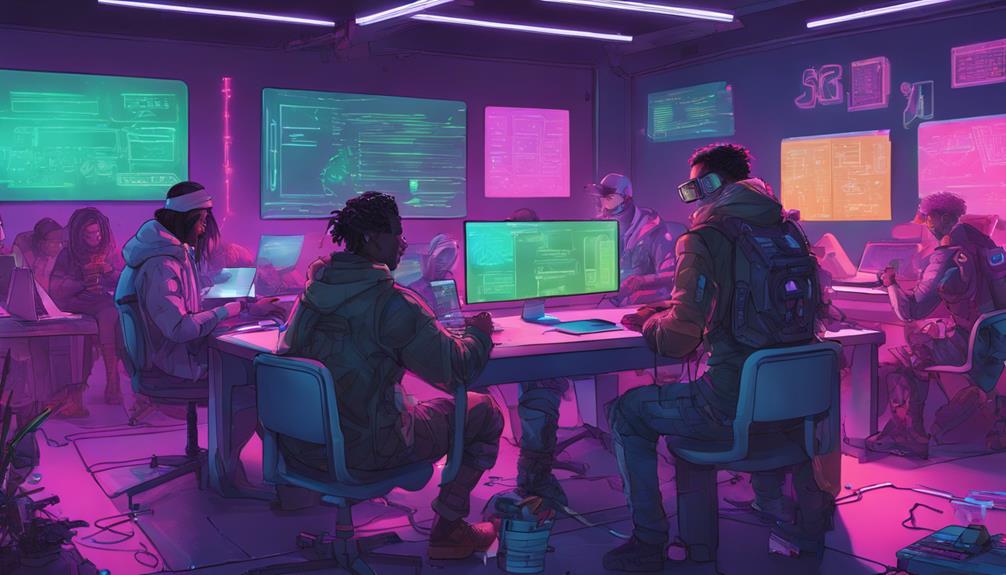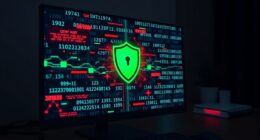AI Hackathons are events driving innovation in supply chains, focusing on critical mineral resilience. These competitions advance AI solutions like georeferencing and automation for survey maps and assessments. The importance lies in safeguarding supply chain flows amidst disruptions. Leveraging AI in forecasting and risk strategies enhances resilience. These events push boundaries for resilient operations through AI integration. Moreover, they optimize supply chain operations, forecasting, and decision-making with advanced algorithms. Benefiting from AI hackathons includes engaging with experts, showcasing solutions, and networking for opportunities. The AI revolution in supply chains fosters efficiency and resilience for the future. Discover more about AI's impact on critical supply chains.
Key Takeaways
- Enhance critical mineral assessments through AI innovation.
- Develop AI solutions for supply chain resilience.
- Focus on automating and optimizing supply chain operations.
- Foster collaboration for robust supply chain management.
- Drive advancements in AI technologies for critical chains.
Overview of AI Hackathons
AI hackathons bring together participants to collaborate on developing innovative AI solutions aimed at enhancing the resilience of critical mineral supply chains. These events serve as platforms for experts to apply cutting-edge technologies like machine learning to automate crucial processes, ultimately expediting critical mineral assessments.
DARPA's AI competitions, which concentrate on georeferencing survey maps and automating assessments related to critical minerals, exemplify this focus on leveraging AI for supply chain resilience. The upcoming 2024 AI hackathons are poised to push the boundaries further by advancing AI technologies specifically tailored for enhancing critical mineral assessments.
Importance of Supply Chain Resilience

Supply chain resilience plays a pivotal role in safeguarding the continuous availability of essential resources for various industries and sectors. Ensuring that supply chains remain robust and adaptable is important for mitigating disruptions and maintaining a consistent flow of goods and services.
AI hackathons, focusing on enhancing the efficiency and reliability of critical mineral supply chains, leverage technical knowledge to address vulnerabilities and optimize processes. Collaborations like DARPA's work with organizations to advance AI technologies for critical mineral assessments highlight the growing recognition of AI's potential in fortifying supply chains.
Challenges faced by the US government in managing critical mineral resources underscore the need for innovative solutions to strengthen supply chain resilience. Companies like Jacobs are already utilizing AI to enhance productivity and address vulnerabilities in supply chains, showcasing the practical application of technical advancements in ensuring the reliability of critical resources for various sectors.
Leveraging AI for Supply Chains

We can leverage AI to optimize supply chains by implementing advanced techniques for efficiency. Through AI-powered forecasting, we can enhance our ability to predict demand and streamline operations.
Additionally, AI enables us to develop robust risk mitigation strategies to guarantee the resilience of our supply chains.
AI Optimization Techniques
Utilizing advanced algorithms, we optimize supply chain operations by leveraging AI to enhance efficiency and resilience. AI optimization techniques play a vital role in automating and refining various facets of the supply chain, leading to improved forecasting accuracy and overall performance.
By harnessing AI capabilities, companies can streamline processes, identify bottlenecks, and adapt swiftly to changing market dynamics. These techniques not only help in reducing costs but also enhance decision-making processes within supply chain operations.
The application of AI in supply chains fosters increased agility, better risk management, and a more robust response to challenges. Through the use of AI optimization techniques, organizations can fortify their critical supply chains, making them more resilient to disruptions and ensuring smoother operations.
This integration of AI not only boosts efficiency but also empowers businesses to make data-driven decisions that contribute to the long-term sustainability of their supply chains.
Supply Chain Forecasting
Enhancing supply chain forecasting through AI-driven analytics optimizes operational efficiencies and strategic decision-making processes. Leveraging AI for supply chain forecasting offers a range of benefits:
- Improved Accuracy: AI technologies can process vast amounts of data to provide more accurate forecasts, reducing errors and enhancing decision-making.
- Efficient Resource Allocation: By analyzing historical data and real-time information, AI can help in predicting demand patterns and optimizing inventory levels, leading to efficient allocation of critical mineral resources.
- Risk Mitigation: AI models can identify potential disruptions in critical mineral supply chains, allowing for proactive risk management strategies to be implemented.
Risk Mitigation Strategies
To optimize risk mitigation strategies in supply chains, AI technologies are leveraged to enhance resilience and efficiency. By incorporating AI, supply chain professionals can harness the power of digital transformation to tackle challenges proactively. Data analytics and visualization play an important role in identifying potential risks and opportunities within critical mineral supply chains. Through collaborations like the one between AI hackathons and DARPA, innovative solutions are being developed to automate assessments and fortify supply chain resilience.
To highlight the importance of leveraging AI in risk mitigation strategies, the table below illustrates key benefits:
| AI Benefits | Description |
|---|---|
| Enhanced Resilience | Utilizing AI for risk mitigation enhances the ability to adapt to disruptions efficiently. |
| Improved Efficiency | AI technologies streamline processes, optimizing supply chain operations for better outcomes. |
| Real-time Data Analytics | AI enables real-time analysis of data, providing insights to make informed decisions promptly. |
| Enhanced Visualization | Data visualization tools powered by AI aid in interpreting complex information more effectively. |
Objectives of AI Hackathons

Our primary goal in AI hackathons is to innovate workflows for critical mineral assessments through the application of AI and machine learning technologies. By leveraging Artificial Intelligence (AI), participants aim to streamline processes, enhance accuracy, and expedite the evaluation of essential mineral resources.
These objectives drive us to explore new horizons in the field of mineral assessment, paving the way for more resilient and efficient supply chains.
- Enhance Automation: Implement AI solutions to automate manual tasks involved in critical mineral assessments, reducing human error and increasing productivity.
- Improve Data Analysis: Utilize machine learning algorithms to analyze vast amounts of geological data swiftly and accurately, providing valuable insights for decision-making.
- Foster Innovation: Encourage creative problem-solving and collaboration among participants to push the boundaries of AI applications in optimizing critical mineral assessment workflows.
Impact of AI on Critical Chains

AI has greatly improved critical mineral assessments by enhancing the efficiency of supply chains and optimizing workflows.
With AI's capabilities, organizations are experiencing a resilience boost in managing the complexities of critical mineral assessments.
The impact of AI on critical chains is undeniable, paving the way for a more streamlined and effective approach to addressing challenges in mineral supply chains.
AI Enhancements in Chains
With AI enhancements in chains, critical mineral assessments are being revolutionized to boost supply chain resilience and efficiency.
AI hackathons are playing a pivotal role in accelerating the evaluation of critical minerals, with a specific focus on enhancing the robustness of supply chains.
DARPA's active involvement in AI projects geared towards critical mineral assessments underscores a strategic alignment with cutting-edge technology to address supply chain challenges effectively.
AI technologies are streamlining traditionally manual processes, leading to significant improvements in the efficiency of evaluating critical mineral resources.
The upcoming 2024 AI hackathons are poised to redefine workflows related to critical mineral assessments, signaling a shift towards more tech-driven and efficient practices.
Jacobs' Open AI Hackathon program serves as a demonstration of AI's potential in increasing productivity and enhancing resource management within critical supply chains.
Optimization Through AI
Revolutionizing critical mineral assessments through AI technologies is optimizing supply chains for enhanced efficiency and resilience. By leveraging AI capabilities in hackathons, we are streamlining the assessment processes of essential minerals, paving the way for more agile and robust supply chains. Traditional methods face challenges that AI and machine learning tools are adept at addressing, leading to quicker and more accurate decision-making in strategic resource management. These AI competitions are driving innovation by automating essential steps in critical mineral assessments, marking a significant shift towards more optimized workflows.
To further illustrate the impact of AI on critical chains, let's examine a comparison between traditional assessment methods and AI-enhanced approaches in the table below:
| Aspect | Traditional Methods | AI-Enhanced Approaches |
|---|---|---|
| Speed of Assessment | Slower due to manual processes | Faster with automation |
| Accuracy of Results | Prone to human error | Improved precision |
| Decision-making Efficiency | Relies on manual analysis | Enhanced by AI algorithms |
| Adaptability to Changes | Limited flexibility | Agile response to variations |
Resilience Boost With AI
As we explore the impact of AI on critical chains, we witness a significant boost in resilience through enhanced automation and innovation strategies. AI hackathons are playing a pivotal role in fortifying the resilience of critical mineral supply chains by leveraging cutting-edge technologies.
Here are three key aspects highlighting the resilience boost provided by AI in critical chains:
- Efficient Resource Management: AI projects, such as those led by DARPA, are streamlining critical mineral assessments to expedite decision-making processes related to resource management. This efficiency guarantees a more agile response to supply chain disruptions.
- Revolutionizing Assessment Techniques: Traditional methods for evaluating critical minerals are undergoing a transformation with the integration of AI and machine learning tools. This revolution is enhancing the accuracy and speed of assessments, contributing to better-informed supply chain strategies.
- Innovative Automation Challenges: Competitors in AI hackathons are tackling complex tasks associated with critical mineral assessments, fostering innovation in automation technologies that can strengthen the resilience of supply chains.
Participant Benefits and Opportunities

Participants in AI hackathons have the chance to engage with cutting-edge technologies like AI and machine learning, providing valuable exposure and hands-on experience in these fields. These hackathons offer a unique opportunity to collaborate with industry experts and policymakers, gaining insights and knowledge that can enrich participants' understanding of the tech landscape.
By actively participating in these events, individuals can enhance their skills in AI and critical mineral assessments through practical, real-world applications. In addition, hackathons serve as a platform for showcasing innovative solutions and ideas, allowing participants to demonstrate their creativity and problem-solving abilities.
Additionally, the networking opportunities at these hackathons can lead to potential job opportunities and partnerships in the tech industry, expanding participants' professional connections and opening doors to new prospects. Overall, engaging in AI hackathons presents a myriad of benefits and opportunities for individuals looking to advance their expertise and make meaningful contributions to the field of technology.
Innovation in Supply Chain Management

We're exploring groundbreaking advancements in supply chain management innovation at AI hackathons. These events serve as hubs for creativity and problem-solving in the field of supply chain resilience, leveraging AI technologies to enhance critical mineral assessments and streamline supply chain processes.
Here are three key aspects of innovation in supply chain management at AI hackathons:
- Integration of AI technologies: Participants utilize AI algorithms to optimize supply chain operations, predict disruptions, and improve decision-making processes.
- Automation and efficiency: AI solutions implemented at hackathons aim to automate routine tasks, reduce manual errors, and enhance overall supply chain efficiency.
- Strategic insights: By analyzing vast amounts of data with AI tools, teams gain valuable insights into supply chain dynamics, enabling proactive risk management and strategic planning.
Through collaborative efforts and cutting-edge technologies, AI hackathons are driving significant advancements in supply chain management practices, paving the way for more resilient and agile supply chains in the future.
Collaboration for Resilient Supply Chains

Exploring the collaborative efforts driving resilience in supply chains through AI hackathons reveals the transformative impact of strategic partnerships in advancing supply chain innovation. Organizations like DARPA have joined forces with entities such as the U.S. Geological Survey to leverage AI technologies for enhancing critical mineral assessments.
DARPA's AI for Critical Mineral Assessment competition, for instance, focuses on automating the extraction of real-world coordinates from survey maps. By automating manual processes and expediting resource evaluations, AI tools are poised to revolutionize critical mineral assessments, thereby fortifying the resilience of supply chains.
Looking ahead, the 2024 AI hackathons are set to further enhance these AI tools, aiming to bolster supply chain resilience through improved critical mineral assessments. These collaborative AI competitions haven't only spurred competitors to tackle challenges in this domain but have also nurtured innovation in technological solutions, paving the way for a more robust and adaptable supply chain ecosystem.
Future of AI in Supply Chain

The future of AI in the supply chain industry is poised for unprecedented growth and disruption as technology continues to evolve rapidly. AI is reshaping how critical mineral assessments are conducted, paving the way for more efficient resource management and supply chain workflows.
Here are three key aspects that highlight the significance of AI in the future of the supply chain:
- Enhanced Efficiency: AI automation streamlines processes, leading to faster and more accurate critical mineral assessments, ultimately improving operational efficiency.
- Scalability: AI technologies have the potential to scale rapidly, allowing for the handling of increased demand for critical minerals expected by 2040.
- Innovation: Collaborations like DARPA's partnership with USGS in AI projects foster innovation, driving the development of cutting-edge solutions for supply chain challenges.
These factors underscore the transformative role AI will play in shaping the future of the supply chain industry, setting the stage for more resilient and agile operations.
Enhancing Operational Efficiency

Efficiency optimization through AI hackathons is a pivotal strategy in enhancing operational effectiveness for critical mineral assessments. By leveraging the power of artificial intelligence, these hackathons aim to streamline processes, accelerate evaluations, and improve overall productivity in assessing critical minerals. DARPA's AI projects, along with initiatives like Jacobs' Open AI Hackathon program, underscore the industry's commitment to automating tasks for quicker and more accurate mineral appraisals. Participants in these hackathons collaboratively develop AI-driven solutions that revolutionize project planning, leading to more efficient resource utilization. The integration of generative AI tools further exemplifies the innovative approaches being explored to enhance operational efficiency in critical mineral assessments. Through the collective efforts of diverse teams in these hackathons, the landscape of mineral assessment is evolving, with a strong emphasis on optimizing operations through cutting-edge AI technologies.
| Benefits of AI Hackathons for Operational Efficiency | ||
|---|---|---|
| Accelerated Evaluations | Streamlined Processes | Enhanced Productivity |
| Automated Tasks | Innovative Solutions | Efficient Resource Utilization |
Frequently Asked Questions
What Is the Supply Chain Resilience Act?
The Supply Chain Resilience Act aims to enhance the resilience of critical supply chains in the United States. Introduced by Senators Tammy Baldwin and Mike Braun, it focuses on key industries and proposes measures to bolster resilience.
What Is Meant by Supply Chain Resilience?
Supply chain resilience means the ability to withstand disruptions and maintain operations. It involves strategies to mitigate risks and guarantee continuity. Our team aims to strengthen supply chains through collaboration and innovative solutions.
What Is the Defense Production Act Drug Shortages?
The Defense Production Act addresses drug shortages by prioritizing critical medical supplies. It empowers the government to control production, distribution, and incentivize essential pharmaceuticals. During emergencies like pandemics, the DPA guarantees an adequate supply to enhance national security.
When Did Biden Take Office?
Biden took office as the 46th President of the United States on January 20, 2021. His inauguration marked the start of his four-year term, succeeding Donald Trump. His administration focuses on key issues like COVID-19, climate change, and economic recovery.
Conclusion
In summary, AI hackathons are essential for enhancing the resilience of critical supply chains. According to recent studies, implementing AI technologies in supply chain management can lead to a 15% increase in operational efficiency.
By leveraging innovative solutions and fostering collaboration, we can secure the future of supply chains is more robust and agile in the face of disruptions.
Let's continue to embrace AI to strengthen our critical chains and drive sustainable success.









